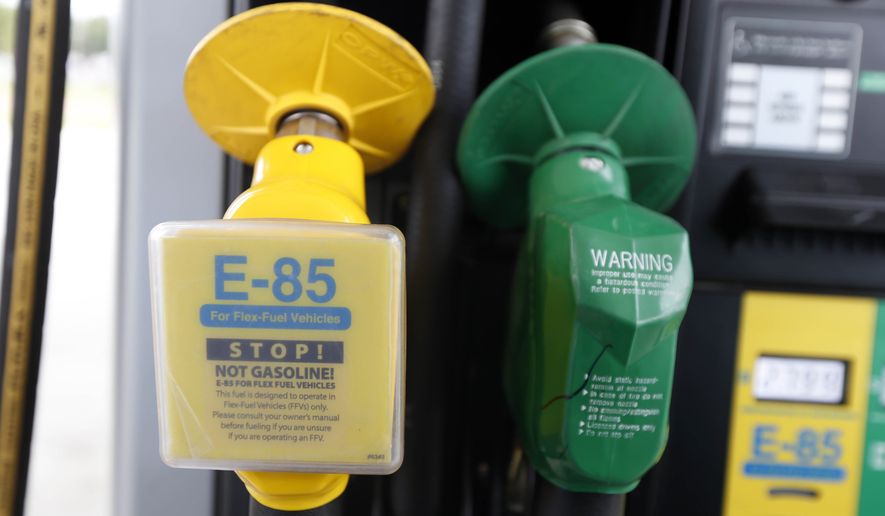Ethanol’s rise over the past decade has given birth to an under-the-radar market: Americans who are willing to travel miles out of their way and pay significantly more per gallon for ethanol-free fuel.
Like locally sourced food or antibiotic-free chickens and eggs, so-called E0, or “pure gas,” has generated a cultlike following willing to pay a premium. More than 12,000 service stations across the U.S. and Canada now offer E0, according to pure-gas.org and other groups that track fuel trends.
While federal mandates make finding pure gas somewhat difficult — the vast majority of stations in the U.S. sell primarily E10, gasoline blended with about 10 percent ethanol — specialists say there is a dedicated market for the product. Some customers may hold fast to the notion that ethanol damages engines over time, or they may want to protest government policies that have forced increased amounts of ethanol into the gasoline supply.
Whatever the reason, the service station owners that sell pure gas, often at a per-gallon price 40 cents higher than E10, have found increasing demand.
“Consumers don’t buy things because retailers sell them. Retailers sell them because consumers want to buy them. If you see an outlet that’s selling pure gasoline, nonblended gasoline, it means there’s a significant demand in the market,” said R. Timothy Columbus, a Washington lawyer who represents the Society of Independent Gasoline Marketers of America and the National Association of Convenience Stores.
“People may have 1,000 reasons they want to buy it,” he said. “Retailers have only one reason they sell it, and that is consumers want it.”
Ethanol proponents attribute the desire for E0 fuel to the public relations war waged by the oil and gas industry, whose share of the fuel market could be chipped away further by growth of the ethanol industry.
Other trade groups, such as those representing small-engine manufacturers, also have taken a public stand against ethanol. They warn that the fuel harms their products and urges the public to be wary of gasoline with increasingly high levels of ethanol.
“We’ve seen these scare tactics from the oil industry and even the small and off-road engine industries. You have the combination of all the negativity being well-funded and the opportunity for these fuel retailers to capitalize on that concern,” said Robert White, vice president of industry relations at the Renewable Fuels Association, a leading ethanol trade group.
While refiners obviously can sell E0 to service station owners who in turn sell it to customers, the underlying process is more complicated.
The 2007 Renewable Fuel Standard, federal legislation passed with bipartisan support and signed by President George W. Bush, called for increased amounts of ethanol to be blended into the nation’s gasoline supply each year. Right now, the mandate calls for a roughly 10 percent blend average.
That doesn’t mean that every single gallon of fuel sold in the U.S. contains 10 percent ethanol. Higher blends such as E15 or E85 are also available at many stations across the country, just as E0 is becoming increasingly common.
To comply with the federal requirements, fuel companies must submit renewable identification numbers, or RINs, to the Environmental Protection Agency.
Companies that sell E0 must have higher blends, such as E15, available elsewhere. If they’ll fall short of the 10 percent average, they can purchase RINs from other companies that exceed the threshold.
“The way it works is because EPA set the standard now just over 10 percent. For every gallon of E0 that gets sold, somewhere else in the country there’s some amount, a corresponding amount, of E85 or E15 or some other fuel that’s being blended into the market to provide the RINs that enable the retailer of E0 to sell that fuel,” said Patrick Kelly, senior fuels policy adviser at the American Petroleum Institute, the oil and gas sector’s leading trade organization.
Mr. Kelly said the API is fully supportive of E10 for highway and nonroad engines.
“Above and beyond that, that’s a whole host of other issues,” he said, reiterating concerns that E15 and higher blends could pose problems for at least some engines.
Moving forward, the ethanol industry believes that E0’s share of the marketplace eventually will peak.
“I think there’s room for growth before they figure out where the market penetration value is,” Mr. White said. “At some point, if the station across the street offers [E0], the margin isn’t going to be as strong. The competition will drive that back down to [consumers saying], ’OK, maybe E10 is a better deal.’”
* Reporting for this story was funded, in part, by the non-profit Washington Policy Institute.
• Ben Wolfgang can be reached at bwolfgang@washingtontimes.com.




Please read our comment policy before commenting.